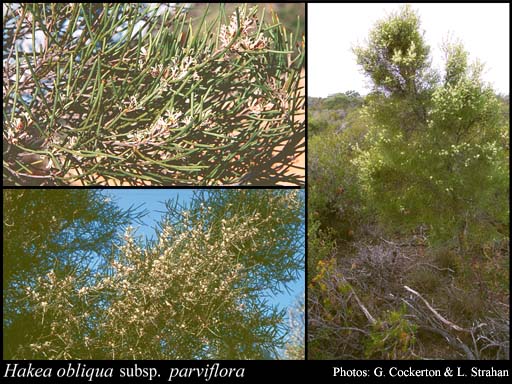- Reference
- J.Adelaide Bot.Gard. 13:99-100 (1990)
- Conservation Code
- Not threatened
- Naturalised Status
- Native to Western Australia
- Name Status
- Current
Compact, non-lignotuberous shrub, 1-1.5 m high. Fl. white/cream-yellow, Aug to Sep. Sand.

Scientific Description
Shrubs, 1.5-3 m high; branchlets hairy. Leaves alternate, 20-65 mm long, 1.5-2 mm wide, glabrous; lamina terete, entire. Inflorescences axillary, cream; pedicels 1.5-2.5 mm long. Perianth 4.5-5.5 mm long, hairy; ovary glabrous; pistil 5.5-6.5 mm long, pollen presenter conical, style glabrous. Follicles 25-35 mm long, 10-15 mm wide, corky tetrahedral projections (on external surfaces of fruit) absent; seed 23-28 mm long (including wing), 8-10 mm wide, the wing continuous. Flowers in May, June, July, August or September. Occurs in the South-west (SW) Botanical Province(s), in the Geraldton Sandplains (GS), Swan Coastal Plain (SWA), Avon Wheatbelt (AW), Jarrah Forest (JF), Mallee (MAL) or Esperance Plains (ESP) IBRA subregion(s).
Distribution
- IBRA Regions
- Avon Wheatbelt, Esperance Plains, Geraldton Sandplains, Jarrah Forest, Mallee, Swan Coastal Plain.
- IBRA Subregions
- Fitzgerald, Katanning, Lesueur Sandplain, Merredin, Perth, Southern Jarrah Forest, Western Mallee.
- IMCRA Regions
- Central West Coast.
- Local Government Areas (LGAs)
- Carnamah, Coorow, Cranbrook, Cunderdin, Dandaragan, Dowerin, Dumbleyung, Gingin, Gnowangerup, Jerramungup, Katanning, Kent, Kulin, Lake Grace, Moora, Plantagenet, Ravensthorpe, Wongan-Ballidu.